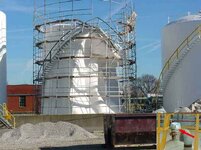mrtangent2
Chemical
- Nov 17, 2020
- 29
This is a curious question Ive been asked. Im quite familiar with a plastic bag blocking a API tank vent and a vacuum being pulled with resulting tank damage => and see it first hand many years ago as a student on an API MEOH Tank.
But, Im fairly sure the answer is NO.. but for API tanks is the probability and do events happen with a budged tank from a vent blockage and over pressure .. e.g with the "right" bit of "crap" so to speak.. is this a credible tank over pressure case .. say from inerts still purging blocked vents..
i think the pressure build would be so slow that its just not likely and doesnt happen..
but i'd like to hear others thougth's on this
But, Im fairly sure the answer is NO.. but for API tanks is the probability and do events happen with a budged tank from a vent blockage and over pressure .. e.g with the "right" bit of "crap" so to speak.. is this a credible tank over pressure case .. say from inerts still purging blocked vents..
i think the pressure build would be so slow that its just not likely and doesnt happen..
but i'd like to hear others thougth's on this

